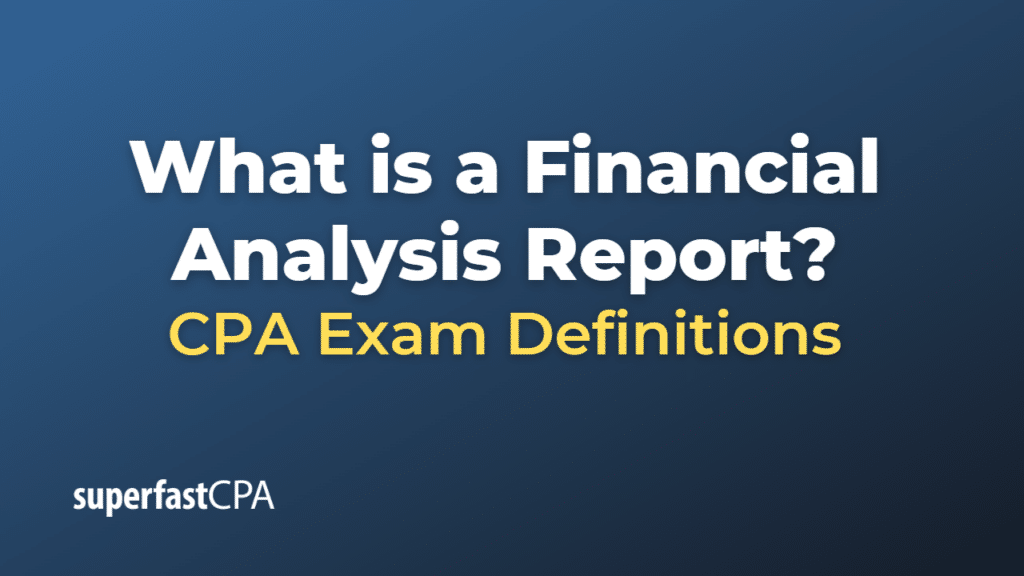Financial Analysis Report
A financial analysis report is a document that contains a detailed evaluation of a company’s financial health. It identifies the company’s strengths and weaknesses by examining various financial and economic factors, including profit margins, return on investment, risk level, efficiency, solvency, and stability.
This report is often used by internal management to make business decisions and by external stakeholders such as investors, creditors, and market analysts to understand the company’s financial position and performance.
A typical financial analysis report may include:
- Executive Summary: This section provides a brief overview of the key findings and conclusions of the report.
- Company Overview: Information about the company, its operations, its market, and its competition.
- Financial Statements: Balance sheet, income statement, and cash flow statement for the relevant period(s).
- Financial Ratios and Trends Analysis: This section includes the calculation and analysis of various financial ratios to evaluate the company’s profitability, liquidity, solvency, and operational efficiency. The report may also analyze trends over time or compare the company’s performance to industry averages or key competitors.
- Investment Thesis or Recommendations: Based on the financial analysis, this section provides an assessment of the company’s current and future financial health. It may include specific recommendations for investors (e.g., buy, hold, or sell) or strategic suggestions for the company’s management.
- Risk Analysis: An assessment of potential risks that could impact the company’s financial outlook. This could include operational risks, market risks, credit risks, etc.
- Conclusion: A summary of the findings and recommendations.
The goal of a financial analysis report is to provide a comprehensive view of the company’s financial health and to guide decision-making for investors and company leadership. However, financial analysis reports have their limitations and should not be used in isolation when making investment decisions or evaluating a company’s performance. Other factors, such as industry trends, market conditions, and management effectiveness, should also be considered.
Example of a Financial Analysis Report
Below is a simplified example of a financial analysis report for a fictitious company, “TechGrowth Inc.”
Executive Summary:
This report provides a financial analysis of TechGrowth Inc., a leading software development company. The company has shown consistent growth in revenue and profitability over the past five years. However, rising operating costs and increased financial leverage are areas of concern.
Company Overview:
TechGrowth Inc., founded in 2010, is a mid-size company specializing in the development and sale of enterprise software solutions. The company operates in a highly competitive market with significant players like Microsoft and Oracle.
Financial Statement Overview:
Our analysis covers the past five years. TechGrowth has demonstrated a consistent growth in revenue, from $1 million in 2019 to $1.7 million in 2023. However, the cost of goods sold (COGS) and operating expenses have also risen during the same period.
Financial Ratio Analysis:
- Profit Margin: The net profit margin has fluctuated between 8% to 10% over the past five years. This indicates a stable level of profitability.
- Current Ratio: The current ratio has decreased from 2.5 in 2019 to 1.7 in 2023, indicating that liquidity has decreased.
- Debt to Equity Ratio: The debt to equity ratio increased from 0.6 in 2019 to 0.9 in 2023. This suggests TechGrowth has been increasingly leveraging debt to finance its operations.
Investment Thesis:
TechGrowth Inc. presents a promising investment due to its steady revenue growth and consistent profitability. However, investors should be aware of the rising costs and increasing leverage, which could pose potential risks.
Risk Analysis:
Key risks for TechGrowth Inc. include stiff competition, reliance on a small number of large clients, and increasing operating costs. The rising debt levels could also strain the company’s financial stability.
Conclusion:
Overall, TechGrowth Inc. appears to be a solid company with strong growth potential. However, management needs to focus on controlling costs and carefully managing its financial leverage.
Please note that this is a simplified and generalized example. A real financial analysis report would be more detailed and contain a more thorough analysis.













